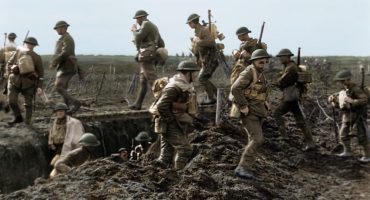
You don’t often hear war veterans talk about their experiences on the battlefield. My father-in-law served in Europe during World War II, but refused to tell me (or his three daughters) what he went through. I know several people who have served in Vietnam, Iraq, and Afghanistan, and while they’re quite open with each other, they’ve clammed up around me — since I wasn’t there, I can never understand.
That’s what makes Peter Jackson’s new documentary, “They Shall Not Grow Old,” so different. It’s the story of Englishmen who went off to fight in World War I, an ugly ground war whose most advanced technology was tanks grinding across open fields. The rest of it was down and dirty, fought with rifles and bayonets, while dodging incoming mortars.
Jackson started with thousands of hours of original footage from the Imperial War Museum, which he and his staff digitized and restored over four years. To make it more palatable to modern audiences, he also colorized and made many of the scenes 3-D. Watching it, you see the fuzzy, original, century-old footage for several minutes, then it suddenly has depth, and when the black-and-white transforms into the greens-and-reds-and-browns of the uniforms and scenery, it’s mesmerizing.
For the audio, there is no narrator, only the voices of men who went off to that war and lived to tell about it in interviews done in the 1950s and 1960s by the BBC and others. They’re all British but, as Jackson explains in a prelude, the experiences were the same for American, French, Australian, and Russian servicemen in that conflict. Being British, the soldiers shown in “They Shall Not Grow Old” have the worst teeth you’ll ever see in a documentary — not a surprise considering the lack of fluoride in the water and the tea-heavy diet, combined with the fact that this was in the first quarter of the 20th century. Remember the crooked, yellowed choppers Mike Myers had as Austin Powers? They would have gotten an A-plus compared to many of these guys.
It makes for a revealing picture of war as told by its survivors, from the boot camp marching lessons to the trenches full of bodies, lice, and mud. Jackson added sound effects to the silent footage, so we hear the impact of the mortars and the whizzing of the bullets overhead. He also, wisely, did not shy away from the goriness of war, the young bodies ripped apart, the blood staining everyone and everything, the misery of being an infantryman in the cold of winter fighting both the elements and the Germans.
This is not a documentary for the faint of heart. Yet it is instructive to recognize that, despite technological changes (air attacks, drones, IEDs, etc.) and different locales, one hundred years later the common currency of war is still blood and body parts, chaos and death. I left the theater horrified for what those men and so many others (including women over the last couple of decades) went through, and the devastating effect on their families — particularly those whose sons signed up at 15 or 16 years old.
I will never experience war first-hand, but Jackson’s work at restoring these images and stories makes it clearer than ever how hellish it was — and, unfortunately, continues to be.
I give “They Shall Not Grow Old” an 8.5 out of 10.
